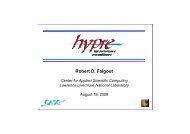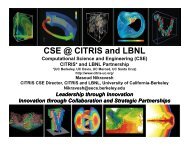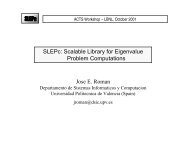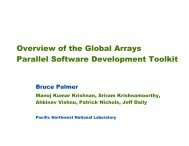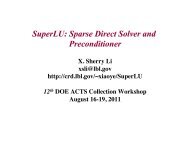Ulrike Meier Yang Hypre team Outline Scalability ... - The ACTS Toolkit
Ulrike Meier Yang Hypre team Outline Scalability ... - The ACTS Toolkit
Ulrike Meier Yang Hypre team Outline Scalability ... - The ACTS Toolkit
Create successful ePaper yourself
Turn your PDF publications into a flip-book with our unique Google optimized e-Paper software.
<strong>Hypre</strong> <strong>team</strong><br />
<strong>Ulrike</strong> <strong>Meier</strong> <strong>Yang</strong><br />
Center for Applied Scientific Computing<br />
<strong>ACTS</strong> <strong>Toolkit</strong> Workshop<br />
October 10-13, 2001<br />
●<br />
●<br />
●<br />
●<br />
●<br />
●<br />
●<br />
●<br />
●<br />
●<br />
Andy Cleary (project leader)<br />
Edmond Chow<br />
Rob Falgout<br />
Van Emden Henson<br />
Jim Jones<br />
Mike Lambert<br />
Jeff Painter<br />
Charles Tong<br />
Tom Treadway<br />
<strong>Ulrike</strong> <strong>Meier</strong> <strong>Yang</strong><br />
CASC<br />
HYPRE 2<br />
<strong>Outline</strong><br />
<strong>Scalability</strong> is a central issue for largescale<br />
parallel computing<br />
●<br />
●<br />
Introduction / Motivation<br />
Getting Started / Conceptual Interfaces<br />
●<br />
●<br />
●<br />
●<br />
Structured-Grid Interface (Struct)<br />
Semi-Structured-Grid Interface (SStruct)<br />
Finite Element Interface (FEI)<br />
Linear-Algebraic Interface (IJ)<br />
●<br />
●<br />
Solvers and Preconditioners<br />
Additional Information<br />
Linear solver convergence can be discussed independent of parallel<br />
computing, and is often overlooked as a key scalability issue.<br />
CASC<br />
HYPRE 3<br />
CASC<br />
HYPRE 4
Multigrid uses coarse grids to efficiently<br />
damp out smooth error components<br />
Getting Started<br />
smoothing<br />
<strong>The</strong> Multigrid<br />
V-cycle<br />
●<br />
Before writing your code:<br />
— choose a conceptual interface<br />
— choose a solver / preconditioner<br />
— choose a matrix type that is compatible with your<br />
solver / preconditioner and conceptual interface<br />
Note:<br />
smaller grid<br />
Finest Grid<br />
restriction<br />
prolongation<br />
(interpolation)<br />
●<br />
Now write your code:<br />
— build auxiliary structures (e.g., grids, stencils)<br />
— build matrix/vector through conceptual interface<br />
— build solver/preconditioner<br />
— solve the system<br />
— get desired information from the solver<br />
First Coarse Grid<br />
CASC<br />
HYPRE 5<br />
CASC<br />
HYPRE 6<br />
Multiple interfaces are necessary to<br />
provide “best” solvers and data layouts<br />
Why multiple interfaces? <strong>The</strong> key points<br />
Linear System Interfaces<br />
●<br />
Provides natural “views” of the linear system<br />
●<br />
Eases some of the coding burden for users by<br />
eliminating the need to map to rows/columns<br />
Linear Solvers<br />
GMG, ... FAC, ... Hybrid, ... AMGe, ... ILU, ...<br />
Data Layout<br />
structured composite block-struc unstruc CSR<br />
●<br />
●<br />
Provides for more efficient (scalable) linear solvers<br />
Provides for more effective data storage schemes<br />
and more efficient computational kernels<br />
CASC<br />
HYPRE 7<br />
CASC<br />
HYPRE 8
hypre currently supports four conceptual<br />
interfaces<br />
Structured-Grid System Interface<br />
(Struct)<br />
●<br />
●<br />
●<br />
●<br />
Structured-Grid Interface (Struct)<br />
— applications with logically rectangular grids<br />
Semi-Structured-Grid Interface (SStruct)<br />
— applications with grids that are mostly structured, but<br />
with some unstructured features (e.g., blockstructured,<br />
AMR, overset)<br />
Finite Element Interface (FEI)<br />
— unstructured-grid, finite element applications<br />
Linear-Algebraic Interface (IJ)<br />
— applications with sparse linear systems<br />
●<br />
●<br />
<strong>The</strong>re are four basic steps involved:<br />
— set up the Grid<br />
— set up the Stencil<br />
— set up the Matrix<br />
— set up the right-hand-side Vector<br />
Consider the following 2D Laplacian problem<br />
2<br />
⎧∇ u = f ,<br />
⎨<br />
⎩ u = 0,<br />
in the domain<br />
on the boundary<br />
●<br />
More about each next…<br />
CASC<br />
HYPRE 9<br />
CASC<br />
HYPRE 10<br />
A structured-grid finite volume example:<br />
A structured-grid finite volume example :<br />
settinguptheGrid<br />
Standard 5-point finite<br />
volume discretization<br />
P0<br />
(2,4)<br />
HYPRE_StructGrid grid;<br />
int ndim = 2;<br />
int ilo[2][2] = {{-3, 1}, {0, 1}};<br />
int iup[2][2] = {{-1, 2}, {2, 4}};<br />
HYPRE_StructGridCreate(MPI_COMM_WORLD,<br />
ndim, &grid);<br />
Partition and distribute<br />
P0<br />
P1<br />
(6,4)<br />
(-3,1)<br />
HYPRE_StructGridSetExtents(grid,<br />
ilo[0], iup[0]);<br />
HYPRE_StructGridSetExtents(grid,<br />
ilo[1], iup[1]);<br />
(-3,1)<br />
HYPRE_StructGridAssemble(grid);<br />
CASC<br />
HYPRE 11<br />
CASC<br />
HYPRE 12
A structured-grid finite volume example :<br />
setting up the Stencil<br />
A structured-grid finite volume example :<br />
settinguptheMatrix<br />
(0,1)<br />
(-1,0) (0,0) (1,0)<br />
(0,-1)<br />
HYPRE_StructStencil stencil;<br />
int ndim = 2;<br />
int size = 5;<br />
int offsets[5][2] = {{0,0},<br />
{-1,0}, {1,0},<br />
{0,-1}, {0,1}};<br />
int s;<br />
P0<br />
(2,4)<br />
HYPRE_StructMatrix A;<br />
double values[36] = {4, -1, 4, -1, …};<br />
int nentries = 2;<br />
int entries[2] = {0,3};<br />
HYPRE_StructMatrixCreate(MPI_COMM_WORLD,<br />
grid, stencil, &A);<br />
HYPRE_StructMatrixInitialize(A);<br />
CASC<br />
S1<br />
S4<br />
S0<br />
S3<br />
S2<br />
HYPRE_StructStencilCreate(ndim, size,<br />
&stencil);<br />
for (s = 0; s < 5; s++)<br />
{<br />
HYPRE_StructStencilSetElement(<br />
stencil, s, offsets[s]);<br />
}<br />
HYPRE 13<br />
(-3,1)<br />
S4<br />
-1<br />
S1 S0 S2 = -1 4<br />
S3<br />
-1<br />
CASC<br />
-1<br />
HYPRE_StructMatrixSetBoxValues(A,<br />
ilo[0], iup[0], nentries, entries,<br />
values);<br />
HYPRE_StructMatrixSetBoxValues(A,<br />
ilo[1], iup[1], nentries, entries,<br />
values);<br />
/* set boundary conditions */<br />
…<br />
HYPRE_StructMatrixAssemble(A);<br />
HYPRE 14<br />
A structured-grid finite volume example :<br />
setting up the Matrix (bc’s)<br />
A structured-grid finite volume example :<br />
setting up the right-hand-side Vector<br />
P0<br />
int ilo[2] = {-3, 1};<br />
int iup[2] = { 2, 1};<br />
double values[12] = {0, 0, …};<br />
int nentries = 1;<br />
/* set interior coefficients */<br />
…<br />
P0<br />
(2,4)<br />
HYPRE_StructVector b;<br />
double values[18] = {0, 0, …};<br />
HYPRE_StructVectorCreate(MPI_COMM_WORLD,<br />
grid, &b);<br />
HYPRE_StructVectorInitialize(b);<br />
(-3,1)<br />
(2,1)<br />
S4<br />
-1<br />
S1 S0 S2 = -1 4 -1<br />
S3<br />
0<br />
/* implement boundary conditions */<br />
…<br />
i = 3;<br />
HYPRE_StructMatrixSetBoxValues(A,<br />
ilo, iup, nentries, &i, values);<br />
/* complete implementation of bc’s */<br />
…<br />
(-3,1)<br />
HYPRE_StructVectorSetBoxValues(b,<br />
ilo[0], iup[0], values);<br />
HYPRE_StructVectorSetBoxValues(b,<br />
ilo[1], iup[1], values);<br />
HYPRE_StructVectorAssemble(b);<br />
CASC<br />
HYPRE 15<br />
CASC<br />
HYPRE 16
Symmetric Matrices<br />
Semi-Structured-Grid System Interface<br />
(SStruct)<br />
●<br />
●<br />
●<br />
Some solvers support symmetric storage<br />
Between Create() and Initialize(), call:<br />
HYPRE_StructMatrixSetSymmetric(A, 1);<br />
For best efficiency, only set half of the coefficients<br />
(0,1)<br />
S2<br />
(0,0) (1,0)<br />
S0 S1<br />
●<br />
●<br />
Allows more general grids<br />
— Grids that are mostly structured but have some<br />
unstructured features<br />
— Examples: Structured adaptive mesh refinement,<br />
Block-structured grids, Overset grids<br />
Allows more general PDE’s<br />
— Multiple variables (system PDE’s)<br />
— Multiple variable types (cell centered, face<br />
centered, vertex centered, … )<br />
●<br />
This is enough info to recover the full 5-pt stencil<br />
CASC<br />
HYPRE 17<br />
CASC<br />
HYPRE 18<br />
Semi-Structured-Grid System Interface<br />
(Sstruct)<br />
A block-structured grid example<br />
●<br />
<strong>The</strong>re are five basic steps involved:<br />
— set up the Grid<br />
— set up the Stencils<br />
— set up the Graph<br />
— set up the Matrix<br />
— set up the right-hand-side Vector<br />
●<br />
Consider again the following 2D Laplacian problem<br />
2<br />
⎧∇ u = f ,<br />
⎨<br />
⎩ u = 0,<br />
in the domain<br />
on the boundary<br />
CASC<br />
HYPRE 19<br />
CASC<br />
HYPRE 20
A block-structured grid example :<br />
setting up the Grid<br />
A block-structured grid example :<br />
settinguptheStencil<br />
HYPRE_SStructVariable vars[1] =<br />
{HYPRE_SSTRUCT_VARIABLE_CELL};<br />
int addindex[2] = {1,2};<br />
HYPRE_SStructVariable addvars[1] =<br />
{HYPRE_SSTRUCT_VARIABLE_CELL};<br />
int nparts = 3, part = 0;<br />
int nvars = 1, naddvars = 1;<br />
HYPRE_SStructGridCreate(MPI_COMM_WORLD,<br />
ndim, nparts, &grid);<br />
HYPRE_SStructGridSetExtents(grid, part,<br />
ilo[0], iup[0]);<br />
…<br />
HYPRE_SStructGridSetVariables(grid, part,<br />
nvars, vars);<br />
HYPRE_SStructGridAddVariables(grid, part,<br />
addindex, naddvars, addvars);<br />
(-1,1) (0,1) (1,1)<br />
(-1,0) (0,0) (1,0)<br />
(-1,-1) (0,-1) (1,-1)<br />
S7 S4 S8<br />
S1 S0 S2<br />
S5 S3 S6<br />
HYPRE_SStructStencil stencil;<br />
int ndim = 2, size = 9, var =0;<br />
int s;<br />
int offsets[9][2] = {{0,0},<br />
{-1, 0}, { 1, 0},<br />
{ 0,-1}, { 0, 1},<br />
{-1,-1}, { 1,-1},<br />
{-1, 1}, { 1, 1}};<br />
HYPRE_SStructStencilCreate(ndim, size,<br />
&stencil);<br />
for (s = 0; s < 9; s++)<br />
{<br />
HYPRE_SStructStencilSetEntry(stencil,<br />
s, offsets[s], var);<br />
}<br />
CASC<br />
HYPRE_SStructGridAssemble(grid);<br />
HYPRE 21<br />
CASC<br />
HYPRE 22<br />
A block-structured grid example :<br />
setting up the Graph<br />
A block-structured grid example :<br />
settinguptheMatrix<br />
CASC<br />
HYPRE_SStructGraph graph;<br />
int part = 0, var = 0;<br />
int to_part = 2, to_var = 0;<br />
int index[2] = {2,0};<br />
int to_index[2] = {-1,0};<br />
HYPRE_SStructGraphCreate(MPI_COMM_WORLD,<br />
grid, &graph);<br />
HYPRE_SStructGraphSetStencil(graph,<br />
part, var, stencil);<br />
/* Add entries at part boundaries */<br />
HYPRE_SStructGraphAddEntries(graph,<br />
part, index, var,<br />
to_part, to_index, to_var);<br />
…<br />
HYPRE_SStructGraphAssemble(graph);<br />
HYPRE 23<br />
S7 S4 S8<br />
S1 S0 S2<br />
S5 S3 S6<br />
CASC<br />
=<br />
-1 -1 -1<br />
-1 8 -1<br />
-1 -1 -1<br />
int sentries[2] = {0,3}, nsentries = 2;<br />
int gentries[1] = {9}, ngentries = 1;<br />
HYPRE_SStructMatrixCreate(MPI_COMM_WORLD,<br />
graph, &A);<br />
HYPRE_SStructMatrixInitialize(A);<br />
HYPRE_SStructMatrixSetBoxValues(A,<br />
part, ilo[0], iup[0], var,<br />
nsentries, sentries, values);<br />
…<br />
/* set values at non-stencil entries */<br />
HYPRE_SStructMatrixSetValues(A,<br />
part, index[0], var, ngentries,<br />
gentries, values);<br />
…<br />
/* zero entries outside domain/part */<br />
/* set bc’s at domain boundaries, */<br />
HYPRE_SStructMatrixAssemble(A);<br />
HYPRE 24
Building different matrix/vector storage<br />
formats with the SStruct interface<br />
Finite Element Interface (FEI)<br />
●<br />
●<br />
Efficient preconditioners often require specific<br />
matrix/vector storage schemes<br />
Between Create() and Initialize(), call:<br />
●<br />
<strong>The</strong> FEI interface is designed for finite element<br />
discretizations on unstructured grids<br />
HYPRE_SStructMatrixSetObjectType(A, HYPRE_PARCSR);<br />
●<br />
●<br />
After Assemble(), call:<br />
HYPRE_SStructMatrixGetObject(A, &parcsr_A);<br />
Now, use the ParCSR matrix with compatible solvers<br />
such as BoomerAMG (algebraic multigrid)<br />
●<br />
See the following for information on how to use it<br />
R. L. Clay et al. An annotated reference guide to the Finite Element<br />
Interface (FEI) Specification, Version 1.0. Sandia National Laboratories,<br />
Livermore, CA, Technical Report SAND99-8229, 1999.<br />
CASC<br />
HYPRE 25<br />
CASC<br />
HYPRE 26<br />
Linear-Algebraic System Interface (IJ)<br />
An example for the IJ interface:<br />
settinguptheMatrix<br />
●<br />
●<br />
<strong>The</strong> IJ interface provides access to general sparsematrix<br />
solvers, but not specialized solvers<br />
<strong>The</strong>re are two basic steps involved:<br />
— set up the Matrix<br />
— set up the right-hand-side Vector<br />
HYPRE_IJMatrix A;<br />
HYPRE_ParCSRMatrix parcsr_A;<br />
int nrows = 3, ncols[3] = {3, 4, 4}, rows[3] = {0, 1, 2};<br />
int cols[[11] = {0,1,10,0,1,2,11,1,2,3,12};<br />
double values[11] = {4,-1,-1, -1, 4, -1, -1, -1, 4, -1,-1);<br />
HYPRE_IJMatrixCreate(MPI_COMM_WORLD, ilower, iupper,<br />
jlower, jupper, &A);<br />
HYPRE_IJMatrixSetObjectType(A, HYPRE_PARCSR);<br />
●<br />
CASC<br />
Consider a 5pt 2D Laplacian problem on a 10x10 grid<br />
⎛ A<br />
− I<br />
⎜⎜⎜⎜⎜<br />
⎝<br />
− I<br />
A<br />
O<br />
O<br />
O<br />
− I<br />
⎞<br />
− I<br />
A<br />
⎟⎟⎟⎟⎟<br />
⎠<br />
,<br />
⎛ 4<br />
− 1<br />
A =<br />
⎜⎜⎜⎜⎜<br />
⎝<br />
− 1<br />
4<br />
O<br />
O<br />
O<br />
− 1<br />
⎞<br />
− 1<br />
4<br />
⎟⎟⎟⎟⎟<br />
⎠<br />
HYPRE 27<br />
HYPRE_IJMatrixInitialize(A);<br />
/* set matrix coefficients several rows at a time */<br />
HYPRE_IJMatrixSetValues(A, nrows, ncols,<br />
rows, cols, values);<br />
…<br />
HYPRE_IJMatrixAssemble(A);<br />
HYPRE_IJMatrixGetObject(A, &parcsr_A);<br />
CASC<br />
HYPRE 28
An example for the IJ interface:<br />
setting up the right-hand-side Vector<br />
Additional IJ interface function calls<br />
HYPRE_IJVector b;<br />
HYPRE_ParVector par_b;<br />
int jlower, jupper, nvalues = 100;<br />
int indices[100] = {0,1,…,99};<br />
double values[100] = {1,1,…,1);<br />
HYPRE_IJVectorCreate(MPI_COMM_WORLD, jlower, jupper, &b);<br />
HYPRE_IJVectorSetObjectType(b, HYPRE_PARCSR);<br />
HYPRE_IJVectorInitialize(b);<br />
/* set several coefficients at a time */<br />
HYPRE_IJVectorSetValues(b, nvalues, indices, values);<br />
…<br />
HYPRE_IJVectorAssemble(b);<br />
HYPRE_IJVectorGetObject(b, &par_b);<br />
CASC<br />
HYPRE 29<br />
IJMatrix function calls:<br />
HYPRE_IJMatrixAddToValues(A, nrows, ncols,<br />
rows, cols, values)<br />
HYPRE_IJMatrixGetValues(A, nrows, ncols, rows,<br />
cols, values)<br />
For better efficiency:<br />
HYPRE_IJMatrixSetRowSizes(A, sizes)<br />
HYPRE_IJMatrixSetDiagOffdSizes(A, diag_sizes,<br />
offdiag_sizes)<br />
IJVector function calls:<br />
HYPRE_IJVectorAddToValues(b, nvalues, indices,<br />
values)<br />
CASC<br />
HYPRE 30<br />
Several Solvers and Preconditioners are<br />
available in hypre<br />
●<br />
CASC<br />
Current solver availability via conceptual interfaces<br />
System Interfaces<br />
Solvers Struct SStruct FEI IJ<br />
Jacobi<br />
X<br />
SMG<br />
X<br />
PFMG<br />
X<br />
BoomerAMG X X X X<br />
ParaSails X X X X<br />
PILUT X X X X<br />
Euclid X X X X<br />
PCG X X X X<br />
GMRES X X X X<br />
HYPRE 31<br />
Setup and use of solvers is largely the<br />
same (see Reference Manual for details)<br />
● Create the solver<br />
HYPRE_SolverCreate(MPI_COMM_WORLD,<br />
&solver);<br />
● Set parameters<br />
HYPRE_SolverSetTol(solver, 1.0e-06);<br />
● Prepare to solve the system<br />
HYPRE_SolverSetup(solver, A, b, x);<br />
● Solve the system<br />
HYPRE_SolverSolve(solver, A, b, x);<br />
● Get solution info out via conceptual<br />
interface<br />
HYPRE_StructVectorGetValues(struct_x,<br />
index, values);<br />
● Destroy the solver<br />
CASC<br />
HYPRE 32
Solver example: SMG-PCG<br />
SMG and PFMG are semicoarsening<br />
multigrid methods for structured grids<br />
HYPRE_StructPCGCreate(MPI_COMM_WORLD, &solver);<br />
/* set stopping criteria */<br />
HYPRE_StructPCGSetTol(solver, 1.0e-06);<br />
●<br />
●<br />
Interface: Struct<br />
Matrix Class: Struct<br />
/* define preconditioner (one symmetric V(1,1)-cycle) */<br />
HYPRE_StructSMGCreate(MPI_COMM_WORLD, &precond);<br />
HYPRE_StructSMGSetMaxIter(precond, 1);<br />
HYPRE_StructSMGSetTol(precond, 0.0);<br />
HYPRE_StructSMGSetZeroGuess(precond);<br />
HYPRE_StructSMGSetNumPreRelax(precond, 1);<br />
HYPRE_StructSMGSetNumPostRelax(precond, 1);<br />
/* set preconditioner and solve */<br />
HYPRE_StructPCGSetPrecond(solver,<br />
HYPRE_StructSMGSolve, HYPRE_StructSMGSetup, precond);<br />
HYPRE_StructPCGSetup(solver, A, b, x);<br />
HYPRE_StructPCGSolve(solver, A, b, x);<br />
CASC<br />
HYPRE 33<br />
●<br />
●<br />
●<br />
CASC<br />
SMG uses plane smoothing in<br />
3D, where each plane “solve”<br />
is effected by one 2D V-cycle<br />
SMG is very robust<br />
PFMG uses simple pointwise<br />
smoothing, and is less robust<br />
Our largest run (with PFMG-CG): 1B unknowns on<br />
3150 processors of ASCI Red in 54 seconds<br />
HYPRE 34<br />
BoomerAMG is an algebraic multigrid<br />
method for unstructured grids<br />
●<br />
●<br />
●<br />
●<br />
●<br />
CASC<br />
Interface: SStruct, FEI, IJ<br />
Matrix Class: ParCSR<br />
Originally developed as a general<br />
matrix method (i.e., assumed given<br />
A, x, and b only)<br />
Uses simple pointwise relaxation<br />
Automatically defines coarse “grids”<br />
DYNA3D<br />
PMESH<br />
HYPRE 35<br />
BoomerAMG interface functions<br />
Coarsening techniques:<br />
• CLJP coarsening<br />
• various variants of the classical Ruge-Stüben (RS)<br />
coarsening<br />
• Falgout coarsening (default)<br />
HYPRE_BoomerAMGSetCoarsenType(solver,<br />
coarsen_type)<br />
Relaxation techniques:<br />
• weighted Jacobi relaxation<br />
• hybrid Gauß-Seidel / Jacobi relaxation (default)<br />
• symmetric hybrid Gauß-Seidel / Jacobi relaxation<br />
• further techniques underway<br />
CASC HYPRE_BoomerAMGSetGridRelaxType(solver<br />
l )<br />
HYPRE 36
More BoomerAMG interface functions<br />
ParaSAILS is an approximate inverse<br />
method for sparse linear systems<br />
HYPRE_BoomerAMGSetMaxLevels(solver,<br />
max_levels)<br />
default: 25<br />
HYPRE_BoomerAMGSetMaxIter(solver, max_iter)<br />
default: 20<br />
HYPRE_BoomerAMGSetTol(solver, 10 −7<br />
tol)<br />
default:<br />
HYPRE_BoomerAMGSetStrongThreshold(solver,<br />
strong_thr)<br />
default: 0.25<br />
HYPRE_BoomerAMGSetMaxRowSum(solver,<br />
max_row_sum)<br />
for more efficient treatment of very diagonally dominant portions<br />
CASC<br />
HYPRE 37<br />
of the matrix, default: 0.9<br />
●<br />
●<br />
●<br />
●<br />
CASC<br />
Interface: SStruct, FEI, IJ<br />
Matrix Class: ParCSR<br />
Approximates the inverse of A by<br />
a sparse matrix M by minimizing<br />
the Frobenius norm of I-AM<br />
Uses graph theory to predict<br />
good sparsity patterns for M<br />
Exact inverse<br />
Approx inverse<br />
HYPRE 38<br />
ParaSails interface functions<br />
HYPRE_ParaSailsCreate(MPI_Comm comm,<br />
HYPRE_Solver *solver, int symmetry)<br />
0 nonsymm./indefinite problem, nonsymm.<br />
Preconditioner (default)<br />
1 SPD problem, SPD (factored) preconditioner<br />
2 nonsymm./definite problem, SPD (factored)<br />
preconditioner<br />
HYPRE_ParaSailsSetParams(HYPRE_Solver<br />
solver, double thresh, int nlevel,<br />
double filter)<br />
thresh: drops all entries in symm. diagonally scaled<br />
A less than thresh, default: 0.1<br />
nlevel: m = nlevel+1 , default: 1<br />
filter: post-thresholding procedure, default: 0.1<br />
HYPRE ParaSailsSetLoadbal(solver<br />
CASC<br />
HYPRE 39<br />
PILUT is an Incomplete LU method for<br />
sparse linear systems<br />
●<br />
●<br />
●<br />
●<br />
●<br />
●<br />
CASC<br />
Interface: SStruct, FEI, IJ<br />
Matrix Class: ParCSR<br />
Uses thresholding drop strategy plus a mechanism<br />
to control the maximum size of the ILU factors<br />
originally by Kumar and Karypis for T3D<br />
now uses MPI and more coarse-grain parallelism<br />
uses Schur-complement approach to parallelism<br />
HYPRE 40
PILUT interface functions<br />
Euclid is a family of Incomplete LU<br />
methods for sparse linear systems<br />
HYPRE_ParCSRPilutSetDropTolerance (solver, tol)<br />
default: 0.0001<br />
●<br />
●<br />
Interface: SStruct, FEI, IJ<br />
Matrix Class: ParCSR<br />
HYPRE_ParCSRPilutSetFactorRowSize (solver, size)<br />
default: 20<br />
●<br />
●<br />
Obtains scalable parallelism via<br />
local and global reorderings<br />
Good for unstructured problems<br />
●<br />
http://www.cs.odu.edu/~hysom/Euclid<br />
CASC<br />
HYPRE 41<br />
CASC<br />
HYPRE 42<br />
Euclid interface functions<br />
Krylov solvers interface functions<br />
HYPRE_EuclidSetParams(solver, argc, argv)<br />
if passed on command line<br />
or<br />
HYPRE_EuclidSetParam(solver, name, value)<br />
for each parameter<br />
HYPRE_ParCSRPCGSetMaxIter(solver, max_iter)<br />
HYPRE_ParCSRPCGSetTol(solver, tol)<br />
HYPRE_ParCSRPCGGetNumIterations(solver, iter)<br />
HYPRE_ParCSRPCGGetFinalRelativeResidualNorm(so<br />
lver,norm)<br />
Options:<br />
-level<br />
-bj<br />
-eu_stats<br />
-eu_mem<br />
CASC<br />
factorization level for ILU(k)<br />
use block Jacobi preconditioning instead of PILU<br />
prints summary of timing information<br />
prints summary of memory usage<br />
HYPRE 43<br />
HYPRE_ParCSRGMRESSetKDim(solver, k_dim)<br />
HYPRE_ParCSRGMRESSetMaxIter(solver, max_iter)<br />
HYPRE_ParCSRGMRESSetTol(solver, tol)<br />
HYPRE_ParCSRGMRESGetNumIterations(solver,<br />
iter)<br />
HYPRE_ParCSRGMRESGetFinalRelativeResidualNorm(<br />
solver,<br />
HYPRE 44<br />
CASC
Getting the code<br />
Building the library<br />
http://www.llnl.gov/CASC/hypre/<br />
●<br />
Usually, hypre can be built by typing configure<br />
followed by make<br />
●<br />
Configure supports several options (for usage<br />
information, type ‘configure --help’):<br />
●<br />
<strong>The</strong> User’s Manual and Reference Manual can be<br />
downloaded directly<br />
‘configure --enable-debug’ - turn on debugging<br />
‘configure --with-openmp’ - use openmp<br />
‘configure --with-CFLAGS=…’ - set compiler flags<br />
●<br />
A form must be filled out prior to download. This is<br />
just for our own records.<br />
CASC<br />
HYPRE 45<br />
CASC<br />
HYPRE 46<br />
Calling hypre from Fortran<br />
Reporting bugs<br />
●<br />
C code:<br />
HYPRE_IJMatrix A;<br />
int<br />
nvalues, row, *cols;<br />
double *values;<br />
http://www-casc.llnl.gov/bugs<br />
HYPRE_IJMatrixSetValues(A, nvalues, row, cols, values);<br />
●<br />
Corresponding Fortran code:<br />
integer*8 A<br />
integer<br />
nvalues, row, cols(MAX_NVALUES)<br />
double precision values(MAX_NVALUES)<br />
call HYPRE_IJMatrixSetValues(A, nvalues, row, cols, values)<br />
●<br />
●<br />
Submit bugs, desired features, and documentation<br />
problems, or query the status of previous reports<br />
First time users must click on “Open a new Bugzilla<br />
account” under “User login account management”<br />
CASC<br />
HYPRE 47<br />
CASC<br />
HYPRE 48
This work was performed under the auspices of the U.S.<br />
Department of Energy by Lawrence Livermore National<br />
Laboratory under contract no. W-7405-Eng-48.<br />
CASC<br />
HYPRE 49






